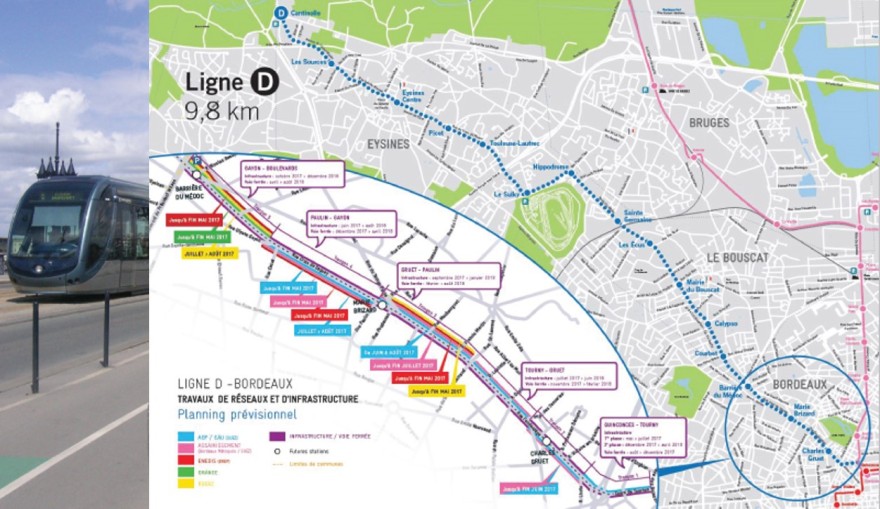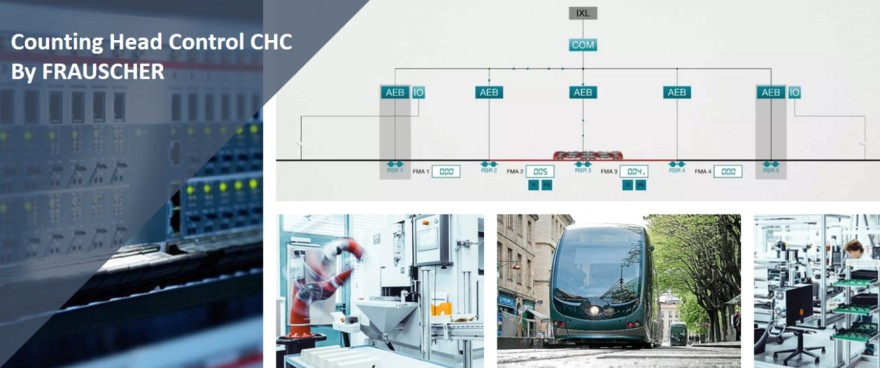Bordeaux Tramway Line
Innovative solutions in the service of safety and of availability
The D line of the Bordeaux tramway is a tram line of the Bordeaux conurbation of about 10 kilometers stretching from the Place des Quinconces, where it connects on the C line, to the Cantinolle terminus. It crosses the municipalities of Bouscat, Bruges and Eysines.
The rail signaling market started on 02 May 2017. Vossloh was initially responsible for the implementation of 5 maneuvering zones: Girondins, Médoc Barrier, Bouscat Town Hall, Le Sulky and a single-track section from Picot Station to Cantinolle station. The commercial commissioning of these D-Line maneuvering areas was initially planned for the end of 2019. During the project to the maneuvering zones of Quinconces and Gruet were added to the scope. This has been a real challenge both in terms of project management and in terms of making available the resources necessary for the proper execution of studies, works and trials.
The responsiveness of all the technical lots involved in this project has enabled the entire D-line to be put into commercial service in two phases:
In general, excluding maneuvering zones for which point machines are installed, the general principle of the operation of a double track tram system is that of "run-on-sight". As such, it is the tram driver who performs the function of "block system", that is to say is able to control its speed, in order to ensure the necessary spacing in relation to the tram preceding it.
Maneuvering areas equipped with point machines must be able to be controlled according to the chosen route, and crossed "safely" to avoid any risk of two-way. In addition, in the portions of tracks that may be travelled in both directions, or even the single-track sections, arrangements must be made to avoid any risk of "face-to-face", this point cannot be ensured by the principle of run-on-sight.
The operating phases of the maneuvering zones implemented in the context of the D-line tram contract in the Bordeaux metropolitan area are as follows:
The technical solutions proposed are based on a mixed architecture such as NS1 safety relay and programmable automaton. These are proven technical solutions already carried out by Vossloh on many tram networks.
Given the technical complexity of implementation or the innovative concept of the product, several technical features of the D-line network, however, are worth highlighting:
Track circuits in APS (ground-level power supply system) zone
These are detection loops used for the interlocking of embedded type turnouts, as well as for the detection of trams in maneuvering areas. The requirement for this system is a minimum level of safety SIL2.
This system has been implemented as part of the D-line market for the Quinconces, Girondins, Gruet, Médoc Barrier, Bouscat Town Hall.
Due to the ground supply system of the trams used for these maneuvering zones and the installation of equipment other than SIGF in an embedded track (e.g. SAE beacon...), the length of track circuits that could be implanted in the track was heavily impacted. In most cases, the length of the track circuits is less than 9m.
The choice of the system retaining a minimum safety requirement SIL2 was therefore strongly impacted.
Vossloh opted for a "Hanning & Kahl" locking circuit system that required a complementary safety demonstration to demonstrate the non-regression of the system's SIL3 safety level in a ground supply system environment.
Axle counting system
The axle counting system consists of track detectors attached to the rails. These are sensors that detect the wheels of the tram in a protective zone. These sensors are placed in the track, which is divided into several sections called "counting zones." The free or occupied track indication is used to ensure the safety of the tram's maneuvers and routes. The requirement for this system is a SIL4 safety level.
As part of the D-line contract, Vossloh has selected the FAdC (Frauscher Advanced Counter) system developed by Frauscher, certified SIL4.
This FAdC system has been implemented on the Le Sulky maneuvering areas and a single-track section from Picot Station to Cantinolle Station.
Depending on the field configuration, the architecture of the axle counting system is more or less complex. In the case of a dual-track maneuvering area such as Le Sulky, all information is processed in a technical room or main cabinet. In the case of a single-track section composed of several sidings, the system will consist of secondary racks processing locally information of sidings and a main rack collecting and processing all the information of the single-track section.

Counting areas can be delimited by multiple sensors and are calculated by associated counting cards, coupled with track detectors. Due to the formation of wheel detectors, the traffic direction information of the trains is available. This information was used to detect the signal at the origin of the closed route and when necessary transmitted to the crossroads controllers. Minor axle counting errors can be re-armed through an operating procedure, while any major errors will require maintenance intervention to get the system back into service.
This SIL4 system fully meets the requirements required in the Line D contract.
Improved availability:
In support of operating availability, the FAdC system incorporates innovative management methods including the
Counting Head Control CHC
.
In order to compensate for the counting errors, which are common in urban areas because they are often caused by abandoned metal objects (papers, cigarettes, soda cans, etc.), some sensors in the track can be set to "sleep" under conditions.
Thus, the system does not interfere during untimely occupations.

Counting points are only "awakened" when rolling stock arrives in the adjacent section of track. This innovative concept patented by Frauscher has been implemented without additional hardware as part of the D-Line contract.
Simple and fully customizable, as part of line D, the management algorithm waits for three successive detections to reactivate the "sleeping" counting head and to indicate an occupation not related to rolling stock.
On all French tram networks equipped with a Frauscher axle counting system, the Bordeaux tramway is the first French tram to benefit from this innovative concept.
